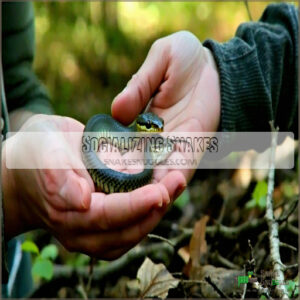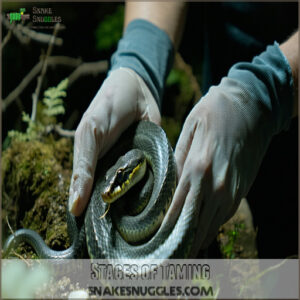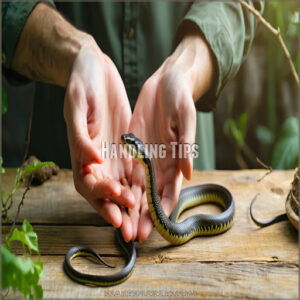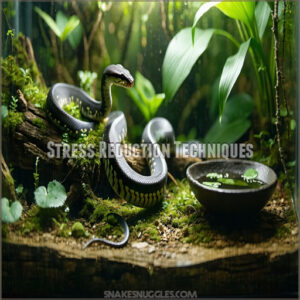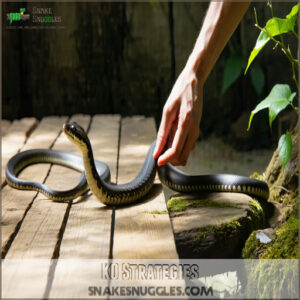This site is supported by our readers. We may earn a commission, at no cost to you, if you purchase through links.
 You’ll find that learning how to tame a snake is like building trust with a shy friend. Start by choosing a naturally docile species like a corn snake – they’re the perfect training wheels for beginners.
You’ll find that learning how to tame a snake is like building trust with a shy friend. Start by choosing a naturally docile species like a corn snake – they’re the perfect training wheels for beginners.
Create a calm environment with proper temperature and hiding spots, then begin with scented gloves to get your snake used to your presence. Keep your movements slow and deliberate, like you’re trying not to spook a nervous cat.
Gradually increase handling time as trust builds, and remember – even the most defensive snake can become a gentle companion with the right approach. There’s an art to reading snake body language that makes all the difference.
Table Of Contents
- Key Takeaways
- How to Tame a Snake?
- Snake Temperament
- Socializing Snakes
- Stages of Taming
- Handling Tips
- Observing Habitat
- Taming Process
- KO Strategies
- Understanding Behavior
- Utility and Role
- Battling Strategies
- Frequently Asked Questions (FAQs)
- How do you handle a snake?
- How to tame baby snakes in Minecraft?
- How do I tame a snake?
- Can snakes be tamed?
- How Do I Know if My Snake is Uncomfortable?
- What Should I Do if My Snake is Not Eating?
- How Often Should I Handle My Snake?
- How Can I Tell if My Snake is Feeling Stressed?
- What Are the Signs That My Snake is Ill?
- How can I tame a snake?
- Conclusion
Key Takeaways
- You’ll need to start with a docile species like a corn snake – they’re easier to tame and less likely to show aggressive behavior compared to other species.
- You should maintain a consistent handling schedule, starting with 10-15 minutes three times weekly, then gradually increasing to 30 minutes five times weekly as your snake becomes comfortable.
- You’ll want to create a stress-free environment with proper temperature, humidity, and hiding spots – this helps your snake feel secure and more receptive to handling.
- You must use scented gloves initially to help your snake get used to your presence, then transition to bare hands while keeping your movements slow and deliberate to build trust.
How to Tame a Snake?

Taming a snake takes patience and a step-by-step approach.
Start by understanding your snake’s species and temperament—corn snakes are docile, while others like black rat snakes may need extra care.
Set up your environment first.
A calm, consistent enclosure helps reduce stress.
Slowly introduce handling using scented gloves to desensitize the snake to human scent.
Handle it gently, avoiding sudden movements, and always support its body.
Stay consistent, building trust through a regular handling routine.
If your snake is aggressive, observe its behavior closely and make adjustments, taking it slow.
With time, it’ll recognize you as non-threatening.
Stick with these snake taming techniques, and soon, you’ll build a confident bond naturally—no magic shortcuts, only persistence pays!
Understanding snake temperament types is important for a successful taming process.
Snake Temperament
Understanding a snake’s temperament helps you predict how it might react to handling and new environments. Different species have unique behaviors, but individual personalities can still vary widely.
General Temperament of Different Snake Species
Understanding snake behavior starts with identifying their temperament types. Corn snakes are famously docile and beginner-friendly, while black rat snakes tend to show semi-aggressive tendencies, especially when cornered.
Kingsnakes? They’re wild cards, ranging from calm to aggressive. Corn snakes are known for their good temperaments as pets.
Aggression factors vary by species and individual behavior. Some snakes, like black rat snakes, may act defensively when startled, while others become testy near feeding time.
Learning snake species identification can help avoid surprises. Even docile snakes may strike if they feel threatened. Always handle carefully, supporting their body and respecting their boundaries, regardless of temperament or habitat influence.
Determining Individual Snake’s Behavior
Every snake has its quirks, and figuring out your snake’s personality is the key to understanding its behavior.
Watch closely for snake behavior patterns, as their actions often reveal how they’re feeling. Are they calm and coiled or hissing and striking? Those are temperament types you’ll want to decode.
Be alert to:
- Environmental factors: Changes in the habitat can cause shifts in snake temperament.
- Aggression triggers: Striking, biting, or hissing often signal stress or fear.
- Individual personalities: Some snakes are natural introverts, while others are surprisingly social.
Recognizing aggressive snake behavior versus signs of docile snakes helps guide your approach. With observation and care, snake behavior modification becomes manageable, even for beginners.
Socializing Snakes
Taming a snake requires patience and a consistent approach to help it feel secure around you.
By gradually handling your snake and respecting its boundaries, you’ll build trust and reduce stress over time.
Time and Patience Requirement
Taming a snake requires patience and a steady hand—literally. Each snake’s initial adjustment period is unique, often influenced by its temperament and past experiences.
New snakes need 7-10 days to acclimate to their new environment. Building trust takes time, so don’t rush the process.
Start with a gradual introduction by spending quiet moments near your snake’s enclosure. This helps it get used to you without feeling threatened. Follow a consistent handling schedule, increasing the time and reducing barriers like gloves as the snake desensitizes to your presence.
Use a calm approach and avoid sudden movements, as these can delay progress. Remember, taming is as much about trust building as it’s about gentle handling.
Here’s a quick guide to help track progress:
| Week | Frequency | Duration |
|---|---|---|
| Week 1 | 3 times weekly | 10-15 minutes |
| Week 2-3 | 4 times weekly | 20-25 minutes |
| Week 4+ | 5 times weekly | 30 minutes+ |
Patience pays off—you’ll see the results in time!
Handling Aggressive Snakes
Dealing with aggressive snakes can feel like walking a tightrope, but it’s entirely possible with patience. Aggression in snakes often stems from territorial instincts or feeding responses.
Start by using scented gloves to help them adjust to your scent without stress. Incorporate gradual handling sessions, beginning with short, calm interactions before progressing to bare hands.
Always use smooth, deliberate movements, as jerky actions can trigger defensive strikes. Stay calm, even if bitten; slowly and gently disengage. Tools like snake hooks can also help safely manage aggressive animals.
Over time, regular, gentle handling can “deprogram” feeding responses and build trust between you and your snake.
- Key safety tips for handling aggression:
- Wear gloves and move calmly.
- Use snake hooks for initial handling.
- Respect boundaries.
- Monitor body language carefully.
Stages of Taming
Taming a snake takes patience and a step-by-step approach to build trust. You’ll start with scented gloves and gentle handling techniques to help the snake feel safe and comfortable.
Introducing Scented Gloves
Start with scented gloves to introduce your snake to your scent in a safe, non-threatening way. Place the gloves near the enclosure, giving your snake time to sniff and explore at its own pace.
This simple step initiates scent desensitization, helping reduce anxiety. Avoid rushing—snakes need time to adjust.
Once comfortable, begin gently handling your snake while wearing the gloves. Keep the sessions short initially, then gradually increase the duration.
This gentle touch and gradual handling help build trust, creating positive associations with your presence. Be patient and consistent—every snake has its own rhythm, so don’t force progress.
With regular practice, snake acclimation becomes easier, setting the foundation for advanced handling techniques. Pair this learning with a good tame snake video for guidance.
Gradual Handling Techniques
Gradual handling techniques are the next step after using scented gloves. Slowly work on handling the snake for 10–30 minutes daily. It’s all about building trust while reducing aggression.
Start by using the gloves, then gradually handle the snake without them for part of the session. This helps with snake desensitization to human touch.
Focus on the snake’s comfort and use a calm approach. Watch its body language, and adjust your handling methods accordingly. A nervous tail twitch or defensive posture means it’s time to pause.
Here’s a simple plan:
- Use gentle touch with proper snake handling equipment.
- Gradually increase contact time, balancing glove and bare hand handling.
- Combine patience with a scent introduction, ensuring the snake associates you positively.
Using proper snake handling gloves is essential for safety.
Patience = progress!
Handling Tips
When handling a snake, focus on being calm, steady, and consistent to build its trust over time.
Use gentle movements and proper support to make sure the snake feels secure and comfortable in your hands.
Maintaining a Schedule
Creating a consistent daily routine is a cornerstone of snake taming techniques.
Regularity in handling sessions helps your snake adapt while reducing stress and aggression. Following a schedule makes your efforts predictable and reassuring for the snake.
Here’s how to structure it effectively:
- Weekly Handling Sessions: Aim for three times a week to build trust without overwhelming your snake.
- Timing Matters: Schedule handling at least 48 hours after feeding times to reduce discomfort.
- Duration Control: Begin with 10-minute sessions, gradually increasing to 30 minutes as your snake becomes more comfortable.
- Scented Gloves: Use gloves scented with bedding material to familiarize the snake with non-threatening contact.
Stick to your schedule, and you’ll foster trust and cooperation while avoiding setbacks in your snake handling journey.
Gentle and Cautious Handling Techniques
Building trust through consistent handling paves the way for gentle, cautious interactions with your snake.
Use a calm approach—snakes sense nervous energy, so stay steady. Quiet movements help avoid startling them, while a safe grip, firm but not tight, provides comfort without constricting.
Always support their body evenly, especially around the first third. Tailor your approach using snake taming techniques—observe each snake’s behavior for cues.
For nervous reptiles, slow, steady handling works best. Keep interactions short at first, gradually increasing time.
Use a gentle touch and respect their space. Remember, patience and these handling techniques make reptile handling rewarding!
Observing Habitat
You’ll need to watch your snake’s habitat closely to understand its natural preferences and behaviors.
By maintaining proper temperature, humidity, and hiding spots, you can create a stress-free environment that helps the taming process.
Preferred Habitat and Behavior
Understanding snake behavior helps you create the right environment for taming.
Snakes have specific habitat needs based on their natural behavior and instincts. Focus on habitat creation that mimics their wild environment to lower stress.
- Moisture matters: Swamp-dwelling snakes thrive with high humidity and dense cover.
- Climbing instincts: Many seek elevated spaces for hunting or safety.
- Privacy preference: Solitary snakes get stressed around other animals.
- Stealth tactics: As ambush predators, they value concealment over speed.
Prioritize habitat simulation by balancing environmental factors like humidity, temperature, and space requirements. Address environmental triggers to guarantee the snake’s comfort and encourage calm, natural behavior.
Stress Reduction Techniques
To lower a snake’s stress, focus on calming methods like maintaining a quiet space and stable temperatures.
Loud noises or sudden movements can unsettle it, so stick to gentle handling and soft speech.
Provide environmental enrichment with hiding spots and proper humidity to mimic its natural habitat.
Sensory desensitization through gradual interaction builds trust and helps with snake taming while respecting its unique animal behaviorism.
Creating a suitable snake habitat kits is essential for successful snake keeping and taming.
Taming Process
Taming a snake takes patience and a step-by-step approach to build trust.
You’ll need to start with small, controlled interactions and gradually increase handling as the snake becomes more comfortable.
Drop Fertilized Eggs Near Unconscious Snake
To strengthen snake trust during taming, egg placement plays a big role.
Start by obtaining fertilized eggs from high-level creatures like Rex or Wyvern. Gently place the eggs near the unconscious snake, ensuring they’re within easy reach but keeping yourself out of sight.
This approach establishes a positive association, as the snake connects the treat with safety in its environment.
Choose a calm taming spot to avoid stress or aggression. The quality of the egg impacts taming speed—better eggs mean faster results.
Focus on egg safety by keeping them stable and undisturbed. This method works well for captive-born snakes, helping them adjust to human interaction and their new snake habitat creation.
Surrounding With Wooden Spike Walls
Wooden spike walls are a clever way to maintain control and safety during snake taming.
They act as a secure barrier, preventing escape and minimizing risks. To guarantee effectiveness, design the walls with sturdy spikes and select durable wood for long-lasting use.
Here’s how to improve your setup:
- Wall Construction: Build walls close enough to block gaps but not restrict airflow.
- Spike Design: Use rounded tips to avoid harming the snake.
- Wood Selection: Choose rot-resistant wood for durability.
- Barrier Effectiveness: Arrange walls in a complete enclosure.
- Snake Deterrents: Ensure no climbable surfaces are exposed.
This controlled environment provides safer taming, builds trust, and simplifies reptile handling.
KO Strategies
To safely tame a snake, you’ll need to use precise knockout strategies that minimize stress and risk.
Focus on tranquilizing methods and clearing the area for visibility to make sure a controlled and safe environment.
Tranquilizing Methods and Precautions
To safely sedate a snake during taming, use tranquilizers like tranq arrows or a longneck rifle, selecting the right tool based on the snake’s size.
Monitor closely for signs of sedation, as improper doses can agitate venom and increase aggression. Maintain clear sightlines for better accuracy—dense vegetation can hinder your shot.
Clearing the area beforehand ensures smoother execution of your knockout strategies. Keep a safe distance to reduce risks while maintaining control.
Effective snake restraint relies on calm, steady actions. Prioritize snake safety precautions by avoiding sudden movements and ensuring proper dosage.
These sedation techniques are essential for a controlled and stress-free taming process. Understanding gentle handling methods is essential for minimizing stress and ensuring a safe interaction with the snake.
Clearing Vegetation for Better Visibility
When taming a snake, improving visibility in its habitat is a smart move.
Thick vegetation can act like a getaway car for your snake, making it harder to monitor or handle. By clearing the area, you’re leveling the playing field.
Here’s how:
- Assess vegetation density: Spot thick patches that block your view or create hiding spots.
- Use proper tools: Grab machetes or shears to trim plants safely and effectively.
- Create clear pathways: Guarantee you’ve got space for smooth, predictable movement.
- Maintain a secure perimeter: Trim nearby plants to block potential escape routes.
This environmental adaptation also enhances visibility and reduces camouflage and concealment opportunities, giving you better control during snake taming.
Understanding Behavior
To tame a snake, you’ve got to understand what makes it feel safe and what triggers its defensive instincts.
Observing its behavior helps you predict its reactions, making handling smoother and less stressful for both of you, which is crucial for a safe and successful interaction based on understanding its behavior.
Passive Nature and Triggers for Aggression
Most snakes are naturally passive, preferring escape over confrontation. However, understanding aggression types is key when taming a snake.
Defensive behavior often stems from environmental triggers like sudden movements, loud noises, or perceived threats to their space. Watch for signs of stress, such as hissing or body flattening, which signal discomfort.
To build trust, move slowly and confidently, offering the snake a clear escape route during handling. Aggressive snakes aren’t inherently mean; they’re just reacting to stress factors.
With consistent, calm handling and proper snake socialization, you can ease their defensive behavior and create a more trusting relationship.
Regurgitation Response to Threats
When a snake feels threatened, its defensive mechanisms may include regurgitation. This defensive behavior allows the snake to lighten its body, making escape easier. Think of it as dropping unnecessary baggage during a race.
Predation threats or stress triggers, like sudden movements or loud noises, can cause this reaction. Improper husbandry can also cause ball python regurgitation. Understanding snake psychology helps you avoid these situations.
For example, if you’re handling your snake, always move slowly and confidently. Jerky movements can stress the snake, activating its threat response. Regurgitation can also occur if a nest or eggs are disturbed, as snakes instinctively protect their young.
By respecting their boundaries, you’ll build trust and improve snake socialization during human interaction.
Utility and Role
Taming a snake isn’t just about making it easier to handle; it can also enhance its role in your care routine.
A well-tamed snake can serve as a calm companion, while its natural behaviors, like guarding instincts, remain intact.
Knockout Capabilities and Torpor
When dealing with aggressive snakes, torpor induction through knockout methods like tranquilizers can make handling safer.
These snake sedation techniques temporarily immobilize the snake, giving you control without provoking aggression. Always make sure the area is clear of obstacles or hiding spots to prevent escapes during sedation.
Monitor the snake closely to adjust your approach if needed. Proper anesthesia safety is critical—never overuse tranquilizers.
These immobilization techniques are invaluable for snake taming, allowing you to handle and socialize the snake more effectively while mastering essential snake handling techniques.
Lifespan Increase and Guarding Abilities
Beyond their impressive knockout abilities, understanding how to optimize your snake’s longevity and defensive capabilities can transform it into a remarkable guardian.
You’ll notice these fascinating creatures naturally increase their lifespan through regular skin shedding, typically occurring every five days when properly cared for.
Here’s what makes snakes excellent guardians:
- Their heightened territorial instincts make them naturally protective of their established space
- Regular feeding schedules and proper stat distribution enhance their guarding effectiveness
- Consistent health optimization through proper habitat maintenance strengthens their protective abilities
- Their passive nature means they’ll only strike when genuine threats appear
With proper snake taming techniques and health management, you’re not just extending their life – you’re developing a loyal sentinel.
Understanding the factors that affect a snake’s wild rattlesnake lifespan is essential for ideal care.
Remember to maintain appropriate distances and respect their space while they patrol their territory.
Think of them as your scaled security system, always alert and ready to protect, utilizing their natural protective instincts and heightened territorial awareness to safeguard their domain, making them a valuable guardian with impressive knockout abilities.
Battling Strategies
You’ll need to build your snake’s strength and defensive abilities through consistent handling sessions before attempting any combat training.
When your snake’s ready for battle, you can boost its effectiveness by practicing controlled strikes and defensive maneuvers in a safe, enclosed space, which enhances its overall effectiveness.
Increasing Melee and Health Stats
While taming a snake requires patience, boosting its combat abilities demands strategic stat distribution. Start by focusing on melee damage upgrades until you reach at least 200% – this guarantees your serpentine companion can effectively defend itself.
Once you’ve enhanced its striking power, turn your attention to health increases. Proper strength enhancement creates a balanced fighter that’s both resilient and powerful.
When planning your snake’s combat training, remember that health stats are just as essential as attack power. Your goal is to develop a well-rounded protector that can both withstand and deliver devastating blows.
Think of stat boosting like building a warrior – you need both a strong sword arm and sturdy armor to survive battles.
Tactical Use for Immobilizing or Taming Other Creatures
Once you’ve mastered taming a snake, you’ll uncover powerful tactics for handling other creatures.
Your scaled companion can be invaluable for Wild Training and Immobilization Techniques.
- Use your snake’s natural striking ability to slow down aggressive animals
- Position snake eggs strategically to attract and tame larger beasts
- Leverage your snake’s camouflage for surprise Creature Control
- Apply learned Animal Tactics to understand other wild creatures’ behaviors
Effective wild animal capture requires the right animal capture gear.
Remember to stay alert – even a well-trained snake maintains its instincts. With careful planning and these taming methods, you can build a strong bond while using your snake’s abilities to help capture and tame other fascinating beasts.
Frequently Asked Questions (FAQs)
How do you handle a snake?
Like a graceful dance, you’ll support your snake’s body confidently while holding it.
Always wash your hands first, avoid sudden movements, and don’t grab the tail or head.
Stay calm if it’s defensive.
How to tame baby snakes in Minecraft?
You can’t tame snakes in Minecraft, but you’ll find other tameable mobs like wolves, cats, and horses.
Feed wolves bones, cats raw fish, and horses golden apples to make them your pets.
How do I tame a snake?
When it rains, it pours! You’ll need patience to handle your snake.
Start with scented gloves, maintain a consistent schedule, and gradually increase handling time.
Avoid sudden movements to build trust.
Can snakes be tamed?
You’ll find that snakes can learn to tolerate handling and recognize you, but they won’t become truly domesticated like cats or dogs.
They’ll adapt to regular interaction through consistent, gentle handling.
How Do I Know if My Snake is Uncomfortable?
Watch for defensive postures – coiled body, rapid tongue flicks, or hissing sounds.
You’ll also notice if your snake’s muscles tense up, it tries to escape, or shows aggressive behavior like striking.
What Should I Do if My Snake is Not Eating?
Check your snake’s temperature and humidity levels first.
If those are correct, try offering smaller prey items, warming the food slightly, or switching prey types.
You’ll need patience during this process.
How Often Should I Handle My Snake?
Like a gentle dance, you’ll build trust with your snake through short, daily sessions.
Start with 5-10 minutes and gradually increase to 15-20 minutes as your snake becomes comfortable with handling.
How Can I Tell if My Snake is Feeling Stressed?
Your snake’s stress signs include rapid tongue flicking, hiding more than usual, refusing food, or tightening into a ball.
You’ll notice changes in movement patterns and defensive postures when they’re feeling uncomfortable.
What Are the Signs That My Snake is Ill?
Your million-dollar pet can’t hide these warning signs: notice regurgitation, lack of appetite, abnormal shedding, respiratory issues, or unusual discharge.
You’ll also spot lethargy, scale problems, or mouth rot affecting their health, which can be indicated by abnormal shedding.
How can I tame a snake?
Begin with short daily visits near your snake’s enclosure.
Then gradually introduce gentle handling using scented gloves.
You’ll want to maintain consistent sessions, avoid sudden movements, and always support their body while handling.
This approach ensures a safe and comfortable environment for both you and your snake, allowing for a positive interaction experience with gentle care.
Conclusion
Ever wondered how rewarding it can be to bond with a scaly friend?
Learning how to tame a snake takes dedication, but the results are worth it.
With consistent handling, proper safety measures, and understanding of snake behavior, you’ll develop a unique connection with your reptilian companion.
Remember, every snake has its own personality, so stay patient and attentive to their cues.
By following these guidelines, you’ll master how to tame a snake and enjoy a fascinating pet experience.


